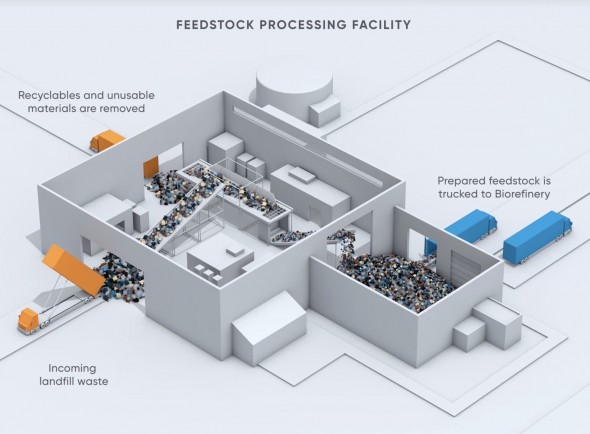NEWSLETTER
In Conversation: Holly Boyd-Boland, Virgin Atlantic


In addition to producing our regular reports (look out for our next one on the carbon removal industry), in this newsletter, we’ll periodically be showcasing companies doing something interesting or innovative in the sustainable aviation field.
Today, we’re looking at Fulcrum BioEnergy, which turns trash into SAF.
Fulcrum says its fuel process involves going “from your trash can to the sky.”
The US company raised $20 million from South Korea’s SK Innovation this Summer, which follows an earlier $50 million equity round last year. Meanwhile, Fulcrum’s major airline partner is United.
Instead of going to a landfill, household garbage is redirected to Fulcrum’s Feedstock Processing Facility. After inorganic materials are separated, a feedstock is produced.
The material then goes through a process of gasification, and syngas clean up, after which it goes through a Fischer-Tropsch reactor – Fischer Tropsch is a proven almost 100-year-old process to produce synthetic fuels
The final stage is then for the resulting product to be upgraded into jet fuel, ready for drop-in into commercial aircraft.
Fifty trucks a day carrying household garbage are due to arrive at Fulcrum’s plant outside Reno, Nevada.
According to US Senator Catherine Cortez Masto:
“There is no or low carbon coming from this clean-burning fuel. That’s what it’s about. How do we lower that carbon footprint? And this is one of the companies that shows how it can be done.”
The Reno, Nevada facility is projected to produce 11 million gallons a year of syncrude from 175,000 tons of municipal solid waste (MSW).
What Fulcrum does is interesting for a number of reasons.
One of the criticisms of SAF is that it takes resources away from agricultural land, which could be used for food crops. Not only does Fulcrum’s fuel not compete for crop space, it also finds a better use for household garbage than further filling up landfill sites,
Industry publication Wastedive cites more examples of waste being turned into jet fuel. Dallas Fort Worth (DFW) has been trialling the use of used cooking oil into SAF.
And the Port of Seattle is likewise looking at how MSW could be turned into fuels.
From SimpliFlying CEO Shashank Nigam:
It’s now possible to find an eco-friendly routing in Google Maps for cars, bikes and public transport. You need not always take the fastest route.
Can airlines take a page out of Google’s book?
What if when searching choosing flights, we can choose the most eco-friendly routing? This goes beyond sorting by CO2e emissions like Google Flights and Kayak offers.
What if airlines could offer non-stop routings or Green Fares like Lufthansa for the most eco-friendly routings? This should include the aircraft type, number of stops, and even weather conditions ideally.
How far do you think we are from an airline doing this?
What I loved about Google Maps is, if you have an electric vehicle (like I do), just search for “EV charging station” on Google Maps to see charging stations nearby, along with helpful details, like port types and charging speeds.
And for some stations, you can even see if a charger is available right now, helping you avoid the wait and save valuable time.
Deal news
United invests $15mn for 200 eVTOLs from Eve (CH Aviation)
Eve was one of the companies featured in our recent UAM Powerlist, click here to read it.
IATA Fly Aware – Sharing environmental knowledge among airlines (IATA)
easyJet Receives Full IATA IEnvA Accreditation for Environmental Management System (Aviation Pros)
Asian airlines have carbon zero in sight as the industry rebounds (NIkkei Asia)
How Honeywell Is Driving Fuel Efficiency At Gulf Air (Simple Flying)
Could gamification help corporate travel go green (Phocus Wire)
Lufthansa Cargo is world’s first cargo airline to use sustainable plastic film for transportation (Indian Transport and Logistics News)
© 2022 SimpliFlying Pte. Ltd.